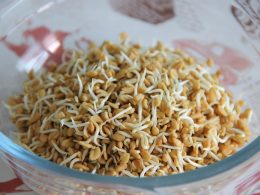Table of Contents
As we age, our bodies begin to break down and often our joints and bones can be the first to be affected. However, aging doesn’t mean you don’t have to be healthy. One common ailment that affects the elderly (and some people of younger ages) is osteoporosis, which literally means ‘porous bone’. This disease reduces the density and quality of your bones, which increases the risk of breaking or damaging your skeleton.
As this disease encroaches gradually, often people will have no idea it is affecting them until their first break occurs. Osteoporosis is a common ailment, but don’t mistake it for a natural or unavoidable consequence of aging.
You can take steps to help prevent osteoporosis and to manage it if you are diagnosed with the condition. By keeping healthy, eating well, and getting exercise, you can keep your body healthy as you age. Here are four ways to deal with osteoporosis.

Vitamin D
It’s important, of course, to take any osteoporosis treatments your doctor prescribes. One helpful supplement is a Vitamin D supplement, as Vitamin D helps strengthens bones. Calcium supplements are also helpful. Post-menopausal women, for instance, need about 1,200 milligrams of calcium per day, but most don’t get enough.
Calcium carbonate supplements are ideal but cause an upset stomach in some people. If you’re one of them, try calcium citrate supplements instead.
These supplements will help strengthen your skeletal and overall body health, which will increase your chances of avoiding the negative effects of aging.
Eat Well
As with most things, what you put into your body has a major effect on what you get out of it. Eating healthy is still one of the best ways to maintain physical equilibrium and strength.
Dietary supplements are a great way to overcome some nutritional shortcomings, but it’s best to get as many nutrients from your food as possible.
Doing so also allows multiple nutrients to work together. Potassium, for instance, neutralizes acid in the body that can leech calcium out of your bones.
To help manage osteoporosis, add salmon, leafy greens, grapefruit and oranges to your diet. Figs are also helpful as are sweet potatoes, prunes and almond butter.
By eating these healthy foods, not only will you manage your diet well, but you will also be able to mitigate the risks of bone health reduction and brittleness. This will keep you safe and strong as you age.
Avoid Falls
Nobody falls on purpose, so avoiding falls may seem like silly advice. It is true that accidents happen, but you can take steps to minimize the risk. Keep your hallways and stairways clear of debris at home. Secure area rugs with an adhesive so they don’t slide out from under you.
Keep your home well lit so you can see and avoid any obstacles. When walking outdoors, use a cane or walker if you need to and try to avoid icy conditions or uneven sidewalks. If you can’t, keep your wits about you and pay close attention to each step you take.
If you have a history of trips and falls, try walking slower and being more mindful of your actions. If you need to, give yourself more time to get to where you need to go and let yourself take breaks and rests.
Get Your Exercise
Working out with osteoporosis can be scary since you don’t want to push too hard and break a bone. But exercise actually improves both balance and bone strength, reducing your risk of a fall or break. The key is to talk to your doctor about an exercise plan that is safe for you.
He may suggest hiking, dancing, aerobics, tennis, or even yard work. If you have other health issues that make these activities unwise, he may recommend lower impact options such as the elliptical machine or walking.
Work with a doctor and a physical therapist to best meet your health needs. By keeping up with exercise, you will be able to keep your body in good condition and avoid the negative effects of aging and osteoporosis.
Remember: your skeletal health is quite literally the backbone of most other physical health. When your structure is strong, your whole body benefits, and when it is weak, your whole body suffers. So take care of your body and get your exercise.
Osteoporosis treatments provide important disease management tools, and they work best when paired with smart lifestyle choices. It’s possible to live an active, healthy life with osteoporosis, so don’t give up on the activities you love. Together, you and your doctor can devise a treatment plan that lets you keep on moving.















